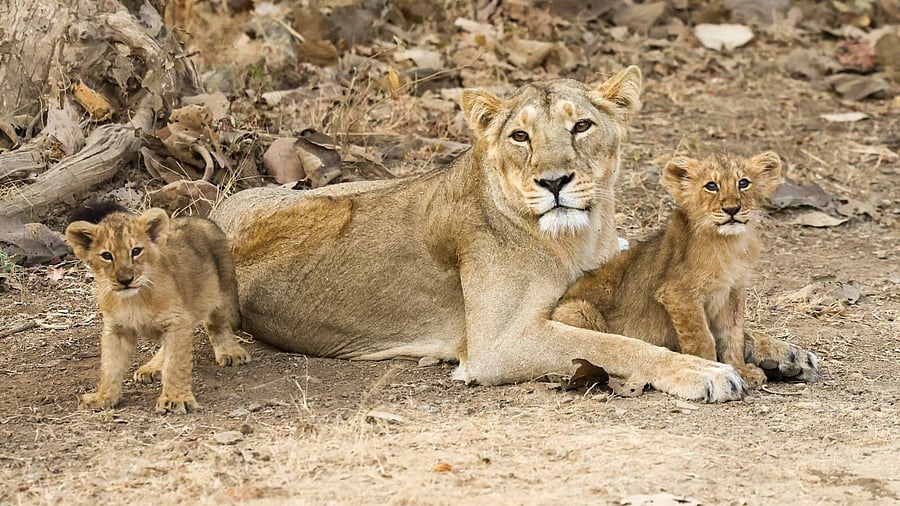
A lioness with her cubs at Gir Wildlife Sanctuary in Gujarat’s Junagadh district.
Photo credit: @narendramodi/ X
Ahmedabad: In Gujarat’s arid Saurashtra region, finding a lion taking a beach walk doesn’t surprise locals anymore. After being pushed to the brink of extinction a century back, the majestic Asiatic lions are now expanding their territory around their last home on earth.
Once ranging from the Mediterranean to the Bay of Bengal, Asiatic lions (Panthera leo) have had a chequered history in the last 100-plus years. They nearly went extinct in the early 20th century but thanks to dedicated conservation efforts, the "king of the forest" narrowly avoided disappearing. What’s more, they seem to be thriving in Saurashtra, though new challenges are arising that challenge long-held beliefs of officials and environmentalists.
With Prime Minister Narendra Modi recently announcing the quinquennial lion census, the 16th such exercise, which will be undertaken in May, the spotlight is back on the big cats of Gujarat.
Once confined to the famous Gir National Park, the Asiatic lions have now reclaimed their ancestral territories in at least nine districts of Saurashtra, spanning over 30,000 square km.
It is said that most of these wild beasts have wandered out of their Gir home in search of larger pastures as their numbers grow. To address this, there have been demands to translocate some of them outside Gujarat. The issue remains contentious in a state where the lions have come to be associated with “Gujarati pride”.
The May 2025 census announced by the PM is likely to witness an increase in the lion count to around 800. In 2020, the population stood at 674, an increase of nearly 29% from 2015.
Satellite homes
A 2022 study published in the journal Nature found that about 48% of the lion population had dispersed outside Gir. It described the big cats staying outside the reserved areas as satellite populations “residing in varying satellite habitats, including undulating terrains, riverine areas and coastal habitats”.
While the rising lion population brings cheer to officials and activists, it has also become challenging to find new territories for them. Over the past couple of years, Barda Wildlife Sanctuary, about 100 km from the Gir park, has become home to 17 lions and is said to have a maximum capacity of hosting about 80-100, though some experts have suggested it can’t accommodate more than 50.
Barda last recorded lions in 1879, about 146 years ago. Interestingly, officials claim the lions found their way to Barda “naturally”, crossing busy highways en route.
A senior forest official told DH that the rising lion population is posing three big challenges — prey base, shelter and water sources. While providing new shelters to the lions is a challenge, when it comes to prey base, the government data claims that it is on the rise.
What is equally notable is the rising instances of lions killing domestic cattle; 2,605 in 2019-20, 3,244 in 2020-21 and 4,385 in 2023-24.
Studies so far suggest that Asiatic lions don’t pose any major problems to humans as they are accustomed to growing near human habitations. A forest officer said farmers have no problem with lions lurking around their farms as this keeps wild boars, blue bulls and other animals away from damaging crops.
This is something that veteran wildlife photographer and environment enthusiast Bhushan Pandya also agrees. Banking on his own experience of closely monitoring lions, he says that unlike African lions, Asiatic lions have grown amid human settlements.
“Maldharis (pastoral community) settlements in the middle of Gir and their coexistence with lions is a perfect example that Asiatic lions don’t have a problem with humans. They grow together, and lions at times kill domestic animals but not Maldharis,” Pandya says.
However, this long-held wisdom took a beating recently.
In conflict with humans
In the past two weeks, activists' and officials' worst fears were realised when lions killed three people, including a seven-year-old child, a farmer, and a visitor. The farmer’s death was particularly gruesome—he was mauled by a lioness, which then sat on the body, forcing forest officials to wait hours to retrieve it. These incidents occurred in the big cats' "new territories" in Amreli and Gir-Somnath districts.
Experts suggest the attacks may be linked to factors beyond lions hunting for food. Pandya explains that lions often attack when disturbed by humans or when they stray into human settlements due to disruptions in their natural habitats. Also, the Gir region, now buzzing with tourists, is seeing an explosion of hotels and homestays, many of which are believed to be illegally built.
Lions’ conflict with humans is likely to increase, says a retired forest official. “There is an ecological imbalance due to commercial activities. The traditional routes of lions have changed and their corridors are disturbed. There are also instances of luring the lions with live baits for tourists,” he says.
When asked if the exclusivist approach of the state government and “Gujarati pride” associated with the lions are hindrances for translocating the animal, Pandya says: “This narrative has been largely created by the media. Translocation will happen but maybe not so fast.”
Studies have shown that a singular population of a species is at a major risk in case of epidemics. There have been instances of Gir lions falling prey to the highly contagious canine distemper virus (CDV) infection.
In 2013, the Supreme Court directed the translocation of lions to Kuno in Madhya Pradesh to create a secondary population, but no action followed. Meanwhile, Kuno has been designated as the habitat for translocated African cheetahs, further limiting the chances of lions relocating outside Gujarat.
It is often said that nature finds its way. However, for the last remaining Asiatic lions, their fate continues to be dictated by humans.